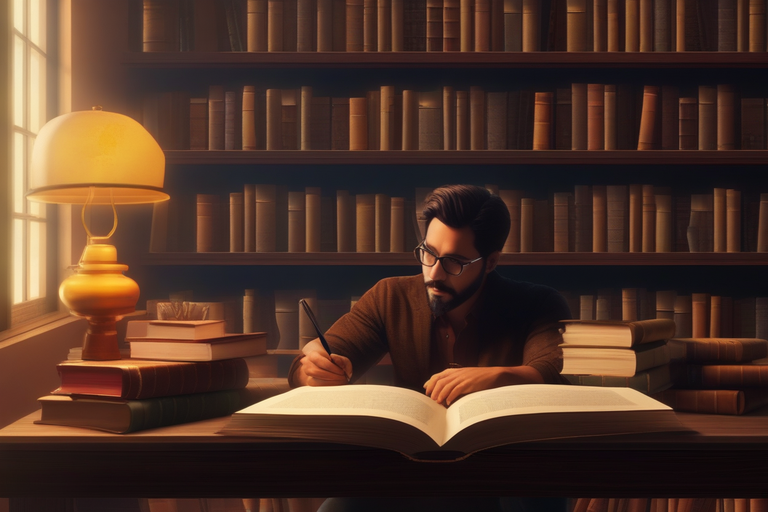Life and Literature : Exploring the Universal Language of Storytelling
Storytelling is an ancient and integral part of human culture. It's a powerful medium that transcends time, culture, and geography, connecting people in a way few other things can. This article explores the evolution of storytelling, its significance in human interaction, and the profound impact it has on us, particularly in the realm of literature.
Storytelling likely began with the very first humans. As they gathered around fires or under the stars, our ancestors used stories to explain the mysteries of the world around them. These early tales were more than mere entertainment; they were a means of preserving history, imparting moral lessons, and strengthening communal bonds.
As human societies evolved, so did the art of storytelling. Oral traditions gave way to written stories with the advent of writing systems. Myths, legends, and folktales were inscribed on tablets, scrolls, and later, printed in books. Each technological advancement, from the printing press to the digital age, has transformed how stories are told and shared.
Storytelling is a uniquely human trait. It's not just about the stories themselves, but the act of sharing them. This communal experience fosters empathy, understanding, and a sense of belonging. In a world that can often feel fragmented, storytelling remains a universal language that can bridge cultural and social divides.
Literature, as a form of storytelling, holds a special place in human culture. It allows us to explore complex emotions, experiences, and ideas in a way that is both profound and accessible. Great literature can challenge our perceptions, broaden our understanding of the world, and provide a mirror to our own lives and societies.
The impact of storytelling on the human psyche is profound. Stories engage our brains in a way that simple facts cannot. They trigger our imaginations, evoke emotions, and often leave a lasting impression. This is why literature, with its rich narratives and complex characters, has such a deep impact on us. It's not just the story that captivates us, but the way it makes us feel and think.
At its core, storytelling is the act of conveying events through words, images, and sounds. It's an art form that involves creativity, imagination, and often, a deep understanding of human nature. A good story can entertain, educate, inspire, and connect us to one another.
Storytelling is more than just a method of communication; it's a fundamental human experience. From the ancient epics to modern novels, stories have shaped cultures, influenced history, and touched countless lives. In our ever-evolving world, the art of storytelling remains a constant, a thread that links past, present, and future generations in the shared experience of being human.
—
Jag TEGEDAO som ligger bakom FactFictionFantasy har som ni vet vid detta laget skapat min egen hemsida LIFE AND LITERATURE dedikerad till allt gällandes främjandet av STORYTELLING! Jag kommer för det mesta publicera mina nya storys där - så ni vet!
STORYTELLING FOR LIFE!
Klicka här >> LIFE AND LITERATURE
—
Final extra: "Holographic Dialogues: Homer and Tolkien on the Essence of Storytelling" - Text Generated by Chat GPT
In a realm where time and space converged in a holographic universe, two great storytellers, Homer and J.R.R. Tolkien, found themselves seated across from each other. The setting was ethereal, a place where thoughts and words manifested into vivid imagery.
Homer, with his eyes that had seen the dawn of epic poetry, spoke first. "In my time, storytelling was the voice of the gods, a medium to convey the divine and the heroic. It was a way to immortalize men and their deeds, to teach and to inspire."
Tolkien, his imagination a tapestry of mythical lands and languages, nodded thoughtfully. "Indeed, Homer. But in my world, storytelling became a mirror to the soul, a creation of alternate realities that reflect our deepest fears and highest aspirations. It's not just a record of the past, but a possibility of what might be."
Their words spun around them, creating holographic scenes from 'The Iliad' and 'The Lord of the Rings'. Achilles' fury shimmered beside Frodo's quiet bravery, Hector's fall intertwined with Gandalf's wisdom.
"Look at how our stories have shaped these images," Homer mused, watching the scenes unfold. "They are not just tales but life itself, breathing and evolving with each telling."
Tolkien smiled, his eyes reflecting the myriad worlds he had created. "And in each age, these stories are reborn, finding new meanings. They are like light - constant yet ever-changing depending on the eye that beholds them."
In that holographic space, where ancient Greece met Middle-earth, the two storytellers understood that while their worlds were ages apart, the essence of their tales was the same. It was about understanding humanity, in all its flawed beauty, and the eternal quest for meaning and connection.
As the images faded, leaving them in a serene silence, Homer and Tolkien realized that storytelling, in any form or era, remains a powerful beacon of hope and understanding, a bridge between the mortal and the immortal, the real and the imagined.
“We tell ourselves stories in order to live.” - Joan Didion




